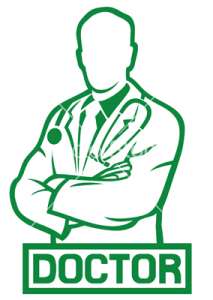

MedFriendly®


Medical Doctor
A Doctor of Medicine (abbreviated M.D. for Medical Doctor) is a
health professional that has earned a degree of Doctor of
Medicine after studying and graduating from a course of study at
an approved medical school.
HOW DOES SOMEONE BECOME A DOCTOR OF MEDICINE?
A highly rated book on this topic is On Becoming a Doctor.
People that go to medical school usually emphasized science
courses when they were in college. There are four basic years
of medical school that must be completed.
When in medical school, the medical student must pass tests known as the National
Board Examination to earn an M.D. This test is usually given in the second year of
medical school, the last year of medical school, and after medical school. After
graduating medical school, an M.D. usually gains additional training in a hospital for
about two years. This additional training is known as residency or internship. After this
training, the M.D. usually begins his or her own private practice or goes on to get
additional training in a specific field of medicine. The length of this training will depend on
the area in which one specializes in. In order to practice medicine, however, the M.D.
needs to get a license in the state that he/she wants to practice in.
WHAT IS THE DIFFERENCE BETWEEN A DOCTOR OF MEDICINE AND A DOCTOR
OF OSTEOPATHIC MEDICINE?
A Doctor of Osteopathic Medicine (commonly abbreviated as D.O.) is a health
professional that has earned a degree of Doctor of Osteopathic Medicine after studying
and graduating from a course of study at an approved medical school. A D.O. needs to
pass the same general criteria to practice medicine as a Doctor of Medicine. However,
someone who trains to be a D.O. focuses on osteopathy during schooling.
"Where Medical Information is Easy to Understand"™
Osteopathic medicine is an approach to medicine that uses
common medical procedures, but it places a greater emphasis on
understanding the relationship between the organs, muscles,
nerves, tissues, bones (such as those that surround the spine), and
tendons, than traditional medical training does. Tendons are groups
of fibers that attach muscles to a bone.
The idea behind osteopathy is that the different parts of the body
are all connected in some way and that the muscles and bones are
most important to a person's well-being. D.O.'s believe that
disturbances in one system of the body can affect other systems.

A D.O. will be able to diagnose and treat medical conditions, prescribe drugs, and perform surgery.
However, due to their extra training in the muscles and bones they will be able to understand and fix
problems with structures of the body (such as bones) by using their hands (a technique known as
osteopathic manipulative treatment). For example, D.O.'s may help patients stretch their muscles or
place pressure on the joints to improve movement. A joint is a place where two bones contact each
other. They also may be more willing to try non-prescription drugs to treat problems, such as herbs. It is
impossible to make a general statement as to whether an M.D. is better than a D.O. or vice versa. There
are some M.D.'s that are better than D.O.'s and there are some D.O.'s that are better than M.D.'s.
WHAT ELSE IS A DOCTOR OF MEDICINE KNOWN AS?
A Doctor of Medicine is also known as a Medical Doctor, a doctor, or a physician. A physician is actually
a general term for someone that that has been educated, trained, and licensed to practice medicine.














